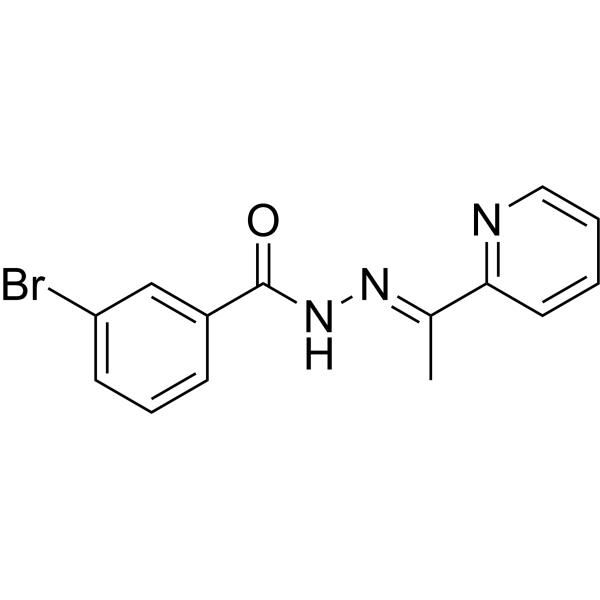Physicochemical Properties
| Molecular Formula | C14H12BRN3O |
| Molecular Weight | 318.168581962585 |
| Exact Mass | 317.016 |
| CAS # | 394668-43-0 |
| PubChem CID | 5341487 |
| Appearance | White to off-white solid powder |
| LogP | 3 |
| Hydrogen Bond Donor Count | 1 |
| Hydrogen Bond Acceptor Count | 3 |
| Rotatable Bond Count | 3 |
| Heavy Atom Count | 19 |
| Complexity | 346 |
| Defined Atom Stereocenter Count | 0 |
| SMILES | C/C(=N\NC(=O)C1=CC(=CC=C1)Br)/C2=CC=CC=N2 |
| InChi Key | GZJPBATWGXWPLE-LICLKQGHSA-N |
| InChi Code | InChI=1S/C14H12BrN3O/c1-10(13-7-2-3-8-16-13)17-18-14(19)11-5-4-6-12(15)9-11/h2-9H,1H3,(H,18,19)/b17-10+ |
| Chemical Name | 3-bromo-N-[(E)-1-pyridin-2-ylethylideneamino]benzamide |
| HS Tariff Code | 2934.99.9001 |
| Storage |
Powder-20°C 3 years 4°C 2 years In solvent -80°C 6 months -20°C 1 month |
| Shipping Condition | Room temperature (This product is stable at ambient temperature for a few days during ordinary shipping and time spent in Customs) |
Biological Activity
| ln Vitro | In a cell line-dependent way, Dp44mT (compound C7) (0-80 μM, 48 h) triggers the lytic cycle; its induction ability in AGS-BX1 cells is higher than that in AGX cells [1]. In a time-dependent manner, the lytic cycle is induced by Dp44mT (10 μM, 0-72 h) [1]. Inducing the EBV lytic cycle, Dp44mT (1.25-2.5 μM, 24 h) works in concert with SAHA and Romidespin, two HDAC inhibitors [1]. Dp44mT (20 μM, 48 h) induces the ERK-autophage axis, which reactivates the EBV lytic cycle [2]. |
| Cell Assay |
Immunofluorescence[1] Cell Types: AGS AGS-BX1 Tested Concentrations: 10 μM Incubation Duration: 24 h, 48 h, 72 h Experimental Results: Resulted the expression of IE proteins Zta, Rta, and early EBV lytic protein BMRF1 peaking at 24h post treatment. Immunofluorescence[1] Cell Types: AGS-BX1 Tested Concentrations: 1.25 μM, 2.5 μM Incubation Duration: 24 h Experimental Results: Synergistically induced the expression of the viral IE protein Zta could together with 2.5 μM of SAHA and 2.5 nM of Rmidepsin. Immunofluorescence[2] Cell Types: HA cells Tested Concentrations: 20 μM Incubation Duration: 24 h Experimental Results: A Dramatically lower expression of Zta was observed in cells treated with the iron-precomplexed C7 when compared to cells treated with C7 with 41% higher. Cell Proliferation Assay[1] Cell Types: AGS, AGS-BX1 Tested Concentrations: 0 μM, 1.25 μM, 2.5 μM, 5 μM, 10 μM, 20 μM, 40 μM, 80 μM Incubation Duration: 48 h Experimental Results: Displayed Dramatically higher toxicity to the EBV-positive cell line AGS-BX1 than the EBV-negative counterpart. |
| References |
[1]. Identification of Novel Small Organic Compounds with Diverse Structures for the Induction of Epstein-Barr Virus (EBV) Lytic Cycle in EBV-Positive Epithelial Malignancies. PLoS One. 2015 Dec 30;10(12):e0145994. [2]. Intracellular Iron Chelation by a Novel Compound, C7, Reactivates Epstein–Barr Virus (EBV) Lytic Cycle via the ERK-Autophagy Axis in EBV-Positive Epithelial Cancers Cancers 2018 Dec; 10(12): 505. |
Solubility Data
| Solubility (In Vitro) | DMSO : ~12.5 mg/mL (~39.29 mM) |
| Solubility (In Vivo) |
Solubility in Formulation 1: ≥ 0.56 mg/mL (1.76 mM) (saturation unknown) in 10% DMSO + 40% PEG300 + 5% Tween80 + 45% Saline (add these co-solvents sequentially from left to right, and one by one), clear solution. For example, if 1 mL of working solution is to be prepared, you can add 100 μL of 5.6 mg/mL clear DMSO stock solution to 400 μL PEG300 and mix evenly; then add 50 μL Tween-80 to the above solution and mix evenly; then add 450 μL normal saline to adjust the volume to 1 mL. Preparation of saline: Dissolve 0.9 g of sodium chloride in 100 mL ddH₂ O to obtain a clear solution. Solubility in Formulation 2: ≥ 0.56 mg/mL (1.76 mM) (saturation unknown) in 10% DMSO + 90% (20% SBE-β-CD in Saline) (add these co-solvents sequentially from left to right, and one by one), clear solution. For example, if 1 mL of working solution is to be prepared, you can add 100 μL of 5.6 mg/mL clear DMSO stock solution to 900 μL of 20% SBE-β-CD physiological saline solution and mix evenly. Preparation of 20% SBE-β-CD in Saline (4°C,1 week): Dissolve 2 g SBE-β-CD in 10 mL saline to obtain a clear solution. Solubility in Formulation 3: ≥ 0.56 mg/mL (1.76 mM) (saturation unknown) in 10% DMSO + 90% Corn Oil (add these co-solvents sequentially from left to right, and one by one), clear solution. For example, if 1 mL of working solution is to be prepared, you can add 100 μL of 5.6 mg/mL clear DMSO stock solution to 900 μL of corn oil and mix evenly. (Please use freshly prepared in vivo formulations for optimal results.) |
| Preparing Stock Solutions | 1 mg | 5 mg | 10 mg | |
| 1 mM | 3.1430 mL | 15.7149 mL | 31.4297 mL | |
| 5 mM | 0.6286 mL | 3.1430 mL | 6.2859 mL | |
| 10 mM | 0.3143 mL | 1.5715 mL | 3.1430 mL |
